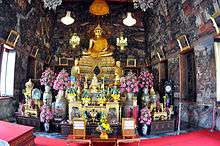Ubosot

An ubosot (Thai: อุโบสถ `ubōsot IPA: [ʔùʔ boː sòt][1]), phra ubosot (Thai: พระอุโบสถ; phra `ubōsot IPA: [pʰráʔ ʔùʔ boː sòt];[1] Pronunciation) or, for short, bot (Thai: โบสถ์; bōt IPA: [bòːt];[1] Pronunciation) is a building in a Buddhist wat. It is the holiest prayer room, also called the "ordination hall" as it is where ordinations take place.
The term ubosot, shortened to bot in Thai colloquial speech, is derived from the Pali term uposathagara, which refers to a hall used for rituals on the uposatha days -- the Buddhist Sabbath, which falls four times a month on the full moon, new moon, and eighth day after each.[2]
An ubosot stands within a boundary formed by eight boundary stones (Thai: ใบเสมา) which separate the sacred from the profane, and thus differs from a wihan (วิหาร). The sema stones actually stand above and mark the luk nimit (Thai: ลูกนิมิต), stone spheres buried at the cardinal points of the compass delineating the sacred area. A ninth stone sphere, usually bigger, is buried below the main Buddha image of the ubosot. Both ubosots and viharns typically house Buddha images. The entrance side of most ubosots face east. Across from the entrance door at the end of the interior is the ubosot's largest Buddha statue.
References
- 1 2 3 Internet dictionary of the Thai language. Retrieved 5 March 2015.
- ↑ Architecture of Thailand. A Guide to Traditional and Contemporary Forms. Nithi Sthapitanonda; Brian Mertens.
Further reading
- Karl Döhring: Buddhist Temples Of Thailand. Berlin 1920, reprint by White Lotus Co. Ltd., Bangkok 2000, ISBN 974-7534-40-1
- K.I. Matics: Introduction To The Thai Temple. White Lotus, Bangkok 1992, ISBN 974-8495-42-6
- No Na Paknam: The Buddhist Boundary Markers of Thailand. Muang Boran Press, Bangkok 1981 (no ISBN)
- Carol Stratton: What's What in a Wat, Thai Buddhist Temples. Silkworm Books, Chiang Mai 2010, ISBN 978-974-9511-99-2
